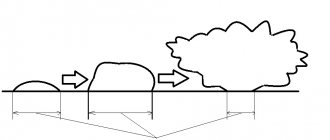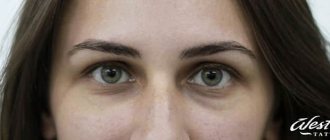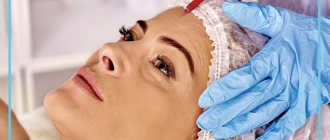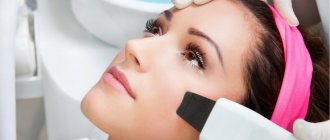Everyone has moles, but their unfortunate location on the body or their shape and size sometimes cause aesthetic discomfort, so the question arises: how to lighten a mole or remove it completely? Lightening a spot on the skin without surgical intervention seems like a harmless procedure, but the method for doing this should be selected carefully so as not to damage the mole or injure the skin.
Whitening of nevi is purely an aesthetic reason for the procedure.
What is the problem with moles anyway?
The problem is that sometimes moles, or, scientifically, pigmented nevi, turn into melanoma. Melanoma is a very dangerous tumor that spreads quickly and leads to death in a short time (several months). More recently, new drugs have emerged that are effective against melanoma; True, they help only some patients, and it is too early to talk about a complete cure: even if all the signs of the disease have disappeared and the person remains healthy for several years, it is not known whether a relapse will occur.
In any case, this is an extremely dangerous disease, which, however, can be prevented or detected at a very early stage, when treatment has a good prognosis.
It is believed that everyone has a risk of melanoma, although it is increased in fair-skinned people with a large number of nevi (moles). The genetic factor also plays a role, so you need to be especially careful if one of your relatives had melanoma.
The most important risk factor is exposure to sunlight, primarily sunburn. The risk of melanoma is thought to be particularly increased if a person had sunburns as a child.
It turns out that the main prevention is protection from sun rays in all its forms: you need to use effective sunscreens, stay in the shade if possible, do not use a solarium and avoid sunburn. And the condition of moles needs to be regularly monitored.
Rehabilitation period
After removal of papilloma, lipoma, atheroma, hemangioma and other neoplasm, the recovery period begins. At this stage, you must adhere to the following recommendations:
- avoid contact of the wound with tap water (the area around the removed nevus is cleaned in the usual way);
- protect the problem area from direct sunlight - with the doctor’s permission, you can use products with an SPF filter;
- treat the wound with medications prescribed by the surgeon - medications with antibacterial, regenerating and softening properties are used;
- Avoid injuring the area with the removed mole.
Plastic surgeon Pavel Ivanov, a specialist in cellular technologies, will excise the nevus effectively and painlessly. Sign up for a consultation now.
How to examine moles and what to pay attention to
English-language authors often come up with abbreviations that are easy to remember - and in the case of examining moles, these are ABCDE: Asymmetry, Border, Color, Diameter, Evolution, that is, asymmetry, contour, color, diameter and changes. What does it mean? Any mole with an asymmetrical shape should raise suspicion, as should any mole with an uneven or unclear outline or uneven color. Particular attention should be paid to moles larger than 5 millimeters and to any changes in them: shape, color, size, the appearance of itching or other unpleasant symptoms.
These signs are independent of each other, and often with early melanoma only one of them is visible to the naked eye. Therefore, it is very important not to wait for multiple changes, but to go to the doctor immediately as soon as you notice any of these five signs, such as a blurred outline or asymmetry. It is better to examine not only moles, but also the entire surface of the skin, especially if you have been sunbathing recently; other types of skin cancer, so-called non-melanoma, do not develop from pigment cells, but are also associated with exposure to sunlight. Therefore, if new strange or unusual elements appear, it is better to consult a doctor.
Medical point of view on lightening moles
Many people who are faced with the problem of unsightly moles believe that it is extremely unsafe to completely remove them, since they are a kind of tumor, so they consult with doctors about the possibility of lightening them. Doctors point out that, in principle, any manipulation of moles without examination by an oncologist can be dangerous.
Is it possible to bleach a mole?
Areas of skin with increased pigmentation may be subject to some lightening. Exfoliating agents that remove the top layer of the dermis, or bleaching agents and cosmetics will help discolor a spot on the skin. It is important to remember that lightened spots on the face stand out much more on the skin, especially if it is tanned. In addition, doctors warn that the use of various medications and cosmetics is permissible only after consulting an allergist. The substances included in the preparations can only worsen the condition of the skin, causing irritation, and some of them have a toxic effect.
Complete removal of “colored” moles is only possible through a surgical procedure.
Is it possible to lighten moles?
Official medicine states that it is impossible to completely whiten moles and they can only be removed surgically. To avoid the formation of new pigmented spots and darkening of existing ones, patients are advised to spend less time in the sun, because it is ultraviolet radiation that affects the formation of melanin pigment in the skin. Those who like to sunbathe should use sunscreen.
Where and how can I get diagnosed?
Of course, it makes sense to regularly examine moles yourself and consult a doctor if you suspect any changes. This could be a dermatologist or oncologist, or a general practitioner who can refer you to the right specialist. In different countries and cities, days of early diagnosis of melanoma are regularly held, where you can get examined for free. In Russia, many clinics in 100 cities are taking part in this event, and the next such day will take place on May 22. Of course, if you are really worried about one of the moles, it is better not to wait for any action, but to consult a doctor immediately.
It is traditionally believed that those who have at least fifty of them on their entire body should pay special attention to moles. But in 2016, one study found that many melanoma patients had much fewer moles, so you can't rely solely on the number of moles. The risk of a large number of nevi is rather that it is difficult to examine them independently, remembering and recording all the changes.
If you want to systematically monitor the condition of all moles on the body, you can use the FotoFinder system, which is available in some clinics. During the examination, the doctor will photograph all areas of the body, highlight on the screen those moles that seem suspicious, and then take microscopic photographs of each of them. All images are saved in a database, and at the next visit (six months or a year later) you can see any changes, if any.
Unattended moles
Some types of moles can degenerate into one of the most malignant tumors - melanoma (skin cancer). The initial site of formation of most melanomas is congenital pigment spots and warty moles.
How does this dangerous development begin? For example, after damage, a person only notices how the color of the mole begins to change, it enlarges, cracks, turns into an ulcer, and sometimes into a tumor. Therefore, without panicking, pay attention to the above symptoms, especially the progressive enlargement of the mole and change in its color.
If all these symptoms occur, immediately rush to the dermatologist. The unfavorable prognosis of melanoma dictates the need for regular monitoring by a doctor. In addition to irritant factors (ultraviolet radiation, trauma), the development of melanoma can also be caused by genetic and endocrine factors. However, in the first place is, of course, excessive exposure to the sun.
Ultraviolet radiation in large doses causes irreversible changes in skin cells, greatly increasing the risk of their degeneration. Light-skinned and fair-haired, red-haired people with blue and gray eyes are most susceptible to the mutagenic effects of sunlight. Those at risk also include those who have a lot of freckles, age spots and moles.
How to remove moles
By and large, birthmarks do not pose a threat to human life and health and are not a pathology, and therefore do not need to be removed.
However, under the influence of various external factors - ultraviolet radiation, trauma, rubbing - age spots can degenerate into melanoma, one of the most malignant human tumors, which can even lead to death. And if the nevus is located in a place that is regularly exposed to contact with clothing, for example, on the sole, in the bra area, on the palm, under the arms, on the waist, neck under the collar, belt, it is recommended to remove it.
And of course, nevi are removed if they create psychological discomfort for their owner.
In traditional medicine they are removed in various ways:
- using liquid nitrogen;
- electric shock;
- using a laser;
- surgically or radiosurgery.
Various creams for removing or lightening nevus have also worked well. They are sold without a prescription and are relatively inexpensive. But doctors categorically prohibit removing moles, warts and papillomas using folk remedies, because such experiments can negatively affect health and even lead to blood poisoning.
But, nevertheless, many people do not dare to turn to surgeons for help and prefer to remove not only warts and papillomas, but also moles using folk remedies.
Summary, or Briefly about the main thing
- The risk of developing a scar after mole removal is higher in the upper half of the body and lower in other areas of the skin.
- When removing large congenital moles, it is better to use a scalpel.
- Removing moles on the scalp, eyelids, palms, feet, and intimate areas is not difficult and, with relatively small nevus sizes, is never associated with scar formation.
And most importantly, remove moles only with histology!
No independence
Some people believe that you can remove moles yourself by tying them, for example, with silk thread. This is a deep misconception. Attempts to bandage warts and papillomas with a thin silk thread often only provoke the growth of these formations. Today, there are celandine-based preparations on sale that are intended to eliminate warts. But it is better not to remove moles, papillomas, or warts yourself by any means.
Celandine juice is similar in composition to iodine, so prolonged exposure to the drug causes skin burns. Cauterization with iodine is even more dangerous - it is more aggressive than celandine. Trying hard to get rid of papillomas with iodine, you can get scars on the skin. Only a dermatologist can properly remove a mole
Features of home mole removal
Before you begin the procedure for removing moles at home, you should know that in some cases, an independent approach may not only not give the expected result, but also significantly harm the patient’s health. It is important to understand that complete removal of a mole is possible only with the help of modern hardware techniques or surgical excision. That is why, it should be assumed that, most likely, it will not be possible to completely eliminate the defect, but it is quite possible to achieve significant lightening of the pigmented part of the nevus.
Having chosen a method for home removal of an aesthetic defect, it is important to adhere to all recommendations and not resort to exposure to aggressive chemical media to burn out the defect, since such exposure can lead not only to severe injury to the epidermal structures, but also to the malignant degeneration of the mole.
Most folk recipes are safe and low-traumatic, but are not able to quickly achieve the desired result.
When turning to home birthmark removal methods, you should be patient and prepare for the need to repeat the steps described below many times.
Medical methods for lightening and reducing moles
It is best to discuss the issue of moles and birthmarks with a vascular surgeon or dermatologist. Experts can recommend several ways to lighten moles and birthmarks.
The most radical method of control is surgical (removal, laser therapy).
Cosmetologists have developed many creams to lighten age spots. Your doctor will recommend a specific prescription after studying your skin type.
Traditional medicine recipes for lightening moles
Let's look at several effective and safe home ways to get rid of moles on the face and body using simple and affordable ingredients:
- Pineapple juice. Using pineapple juice, rich in fruit AHA acids, is one of the most effective ways to remove dark-colored moles. The essence of the technique is the acid destruction of pigmented nevus cells under the lysing effect of natural acid. At the same time, the lightening effect of pineapple extract manifests itself gently and not immediately. As a result, by regularly wiping the location of the mole with a cotton swab dipped in pineapple juice, it is possible to achieve significant lightening of the epidermal defect without injuring the surrounding tissues.
- A mixture of natural fatty oil and honey. Castor or linseed oil is used. With regular application of these components to a mole, patients note a lightening of the formation and a straightening of its shape. You can significantly increase the effectiveness of the technique by adding a few tablespoons of natural honey to the oil. This folk recipe is recommended to be used once every two days.
- Onion or dandelion juice. The destruction of pigmented structures in this case is achieved due to the high content of ascorbic acid (vitamin C), which itself exhibits an active destructive effect on the cell membrane. By rubbing an unwanted mole with onion juice or dandelion extract, patients notice a significant lightening and reduction in the size of the mole.
- Celandine juice. A rather dangerous way to eliminate such epidermal structures as moles and warts, which can cause severe burns and, as a result, the formation of scars and cicatrices. It is for this reason that it is not recommended to wipe nevi located on open areas of the body with celandine juice.
- Birch juice. Birch sap, rich in vitamins and antioxidants, when used regularly for washing, demonstrates a visible whitening effect on both moles on the face and epidermal structures in general.
- A mixture of chalk and hemp oil. The solution is prepared by mixing the two components in a ratio of 1:4. Next, it is recommended to infuse the mixture for several days and wipe the mole with the resulting composition twice a day. The manipulation must be repeated regularly for at least a month.
- Vinegar essence. The use of vinegar essence is justified from the point of view of cauterization of nevi. It is believed that if you apply this liquid to the location of the stain, one drop per day, you will be able to completely get rid of the pigmented area. In addition, you can speed up the process of eliminating skin imperfections by adding chopped garlic cloves to the essence. In this case, the product is used as a compress and secured to the body with an adhesive plaster. In fact, this method has proven itself to be quite effective as a method for removing moles from the body, but it should not be used on the face and neck due to the aggressiveness of the active agent .
As a ready-made pharmaceutical product for removing pigmented neoplasms (moles) at home, the same vitamin C can be used, which is purchased both in the form of a solution and as tablets. In this case, the ascorbic acid tablet must be thoroughly crushed and applied to the nevus in powder form.
It is important to ensure that the powder does not contain artificial coating particles or glucose, which are sometimes used in the production of medications.
Despite the simplicity and accessibility of most of the recipes listed above, if you notice a change in color, shape or sensations associated with a mole, you should still consult a qualified specialist who will eliminate the risk of oncological transformation.
In a modern clinic, mole removal can be carried out through cryodestruction, laser correction and electrocoagulation, which makes it possible to quickly get rid of a pigmented defect, while avoiding scar formation and other complications that are fraught with self-medication.
Where do they appear most often?
The most common places where moles appear are the head, neck and torso. There are significantly fewer requests for removal of nevi on the extremities.
On which areas of the skin is which removal method is better?
In my opinion, when choosing a removal method, the location of the mole should be the last thing to consider. Much more important in this area are the size of the mole and how long it has existed (from birth or not). For example, a mole on the face larger than 5 mm and on the body larger than 1.5 cm is better to remove with a scalpel rather than with a laser/radio-knife/electrocoagulation. This is due to the fact that in the case of a scar, which can develop with any method, the scar tissue will be more invisible when removed with a scalpel.
Shape of the scar when removed with a scalpel (left) and laser/radio-knife/electrocoagulation (right)
It is better to remove both congenital moles and those that appeared during the first year of life with a scalpel. However, the reason here is different - this type of mole, as a rule, is located deeper in the skin than acquired ones. With a superficial method of removal (laser/radio-knife/electrocoagulation) of these nevi, there is a possibility that the mole will not be completely removed and the chance of relapse will increase. This condition in itself is not dangerous, but can be noticeable in cosmetically significant areas.
Where are scars most likely to occur when moles are removed?
Everything is simple here - the red in the picture shows the places where the risk of scarring is maximum when removed, yellow - average, green and gray - minimal.
Features of removing moles on the head
Read more about removing moles on the head in this article. Now I will briefly examine the main myths about moles on the head.
Myth No. 1. When removing moles on your head, you need to shave off half of your hair.
No, this is not required, at least when removing moles up to 1.5 cm in diameter with laser/radio-knife/electrocoagulation. Shaving is necessary only for surgical treatment of large formations - more than 2 cm.
Myth No. 2. After removal, you must walk for a long time with a bandage on your head.
A bandage is not required when removing small moles up to 1.5 cm - the wound heals like a regular deep scratch. To care for it, you need regular self-treatment.
Myth No. 3. After the mole is removed, bald spots will remain.
No. In most cases, after 1-2 months it is almost impossible to find the place where the mole was removed.
In my practice, I have never seen a scar after removing a mole on the scalp.
Removing a mole on the head: before and after
Removing moles on the face
For facial skin, it is important to consider 2 circumstances:
- mole size;
- duration of existence - since birth or not.
If the size exceeds 5–7 mm, this is a reason to choose a scalpel. This tool will be even more relevant if the mole is congenital or appeared during the first year of life.
Removing a mole on the face with a scalpel
In other cases, acquired moles no larger than 5–6 mm in size are ideal
superficial removal methods - radio knife/electrocoagulator/laser.
Removing a mole on the face using radio waves
Remove a mole on your lip? Please.
A mole on the lips is a rare occurrence. Those who are “lucky” with this often think that removal is impossible, but they are wrong. The rules here are the same as with moles on other parts of the body - for large ones - a scalpel, for small ones - other methods that allow you to send a mole for histology.
Removing a mole on the lip: before and after
Moles on the eyelids
-Horror! There is absolutely no way to remove a mole on the eyelid, because it is so close to the eye, and if something happens, you could be left without an eye, many fear.
Fortunately, this opinion is also wrong. Small moles that do not extend to the edge of the eyelid can be easily removed. An even more pleasant thing is that the skin around the eyelids is practically not prone to scarring.
Removing a mole on the eyelid: before and after
During the procedure, it is worth protecting the eye with a special shield.
Eye protection when removing a mole on the eyelid
With such protection, removal becomes 100% safe for the eye.
Removal of moles on feet and palms
There is a stereotype that moles in these places are especially dangerous in terms of the development of melanoma. I couldn't find any research to support this. The only thing we managed to dig up was that with dermatoscopy, differential diagnosis between early melanoma and atypical nevus can be difficult [1].
As a rule, nevi of the palms and soles do not protrude above the skin level and rarely require removal. If it is still carried out and the size of the mole does not exceed 5 mm, scars are practically not formed.
Mole on the palm
Mole on the foot
Moles in the intimate area: in the perineum and on the genitals
In most cases, removal of nevi in these areas occurs without problems. The only difficulty: the genitals and perineum have more nerve endings than the body or limbs. In this regard, the anesthetic injection given before the operation will be more noticeable than, for example, on the back. There are no other differences during removal, except for slightly faster healing compared to other areas of the skin.
Moles in the armpits
There are no special features here. Moles in the armpits are removed quite easily and usually heal without problems, like any other moles located in the hair growth area.
Mole removal in the armpit: before and after
How to lighten moles on the face
Skin lightening is a set of simple procedures that should be carried out regularly over a period of time. For these procedures, you can use both specialized cosmetics sold in pharmacies and stores, and a variety of folk recipes.
The most effective remedy that will help remove excess melanin from the deep layers of the dermis is a mask. It will provide high-quality and long-term results. You can prepare it yourself from various ingredients, many of which can be found in the average refrigerator.
The most effective recipes are:
- A mixture of white clay with lemon juice dries the skin, whitens it, tightens pores, prevents the appearance of wrinkles, and effectively strengthens the walls of blood vessels;
- Mousse made from honey and sour cream is a real treat for the skin, which makes it lighter, smoother, softer and cleaner;
- A paste of cucumber pulp and parsley leaves saturates the skin with vitamins, effectively whitens it, and has an antibacterial effect.
Whatever method you choose, remember that lightening your face is a responsible undertaking. Before you start, you should consult a dermatologist or professional cosmetologist.
Dangerous sun
For each person, the critical duration of exposure to sunlight is highly individual. It’s not easy to determine this line, so it’s better to just remember that prolonged exposure to the sun is harmful to the body. The skin is forced to protect itself from ultraviolet radiation. Excessive tanning means inevitable burns.
If you love beach holidays so much that you simply cannot deny yourself this pleasure, at least listen to the following tips.
By following these simple recommendations, you will not only improve your health, but also reduce the risk of a dangerous disease:
- Staying in the sun is safe from morning until 10 o'clock, in the evening after 17 o'clock.
- For people with a large number of moles, it is better to reduce their exposure to the sun.
- Try to avoid redness and sunburn on your skin. If this happens, spend 2-3 days in the shade.
- After swimming in the sea, be sure to rinse your skin with fresh water.
- Even young and healthy people can spend no more than one and a half to two hours a day in the sun.
- Taking certain medications increases the skin's sensitivity to light. Please consult your GP before going on holiday.
- Use sunscreen cosmetics: at the beginning of the holiday, the indicator should be maximum, about 40 units.
- Do not use decorative cosmetics, deodorants and perfumes on the beach - they can cause the appearance of age spots on the skin.










